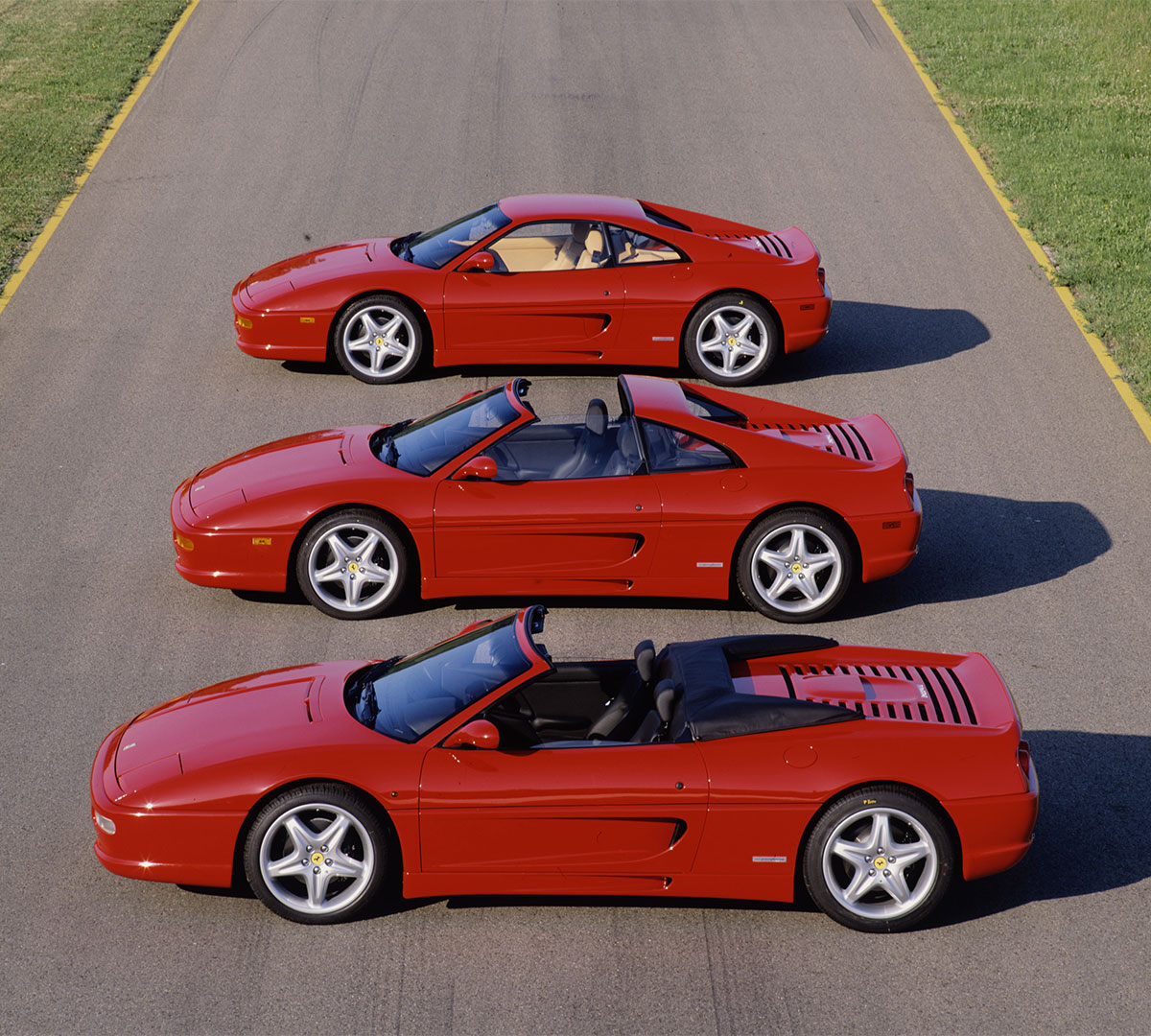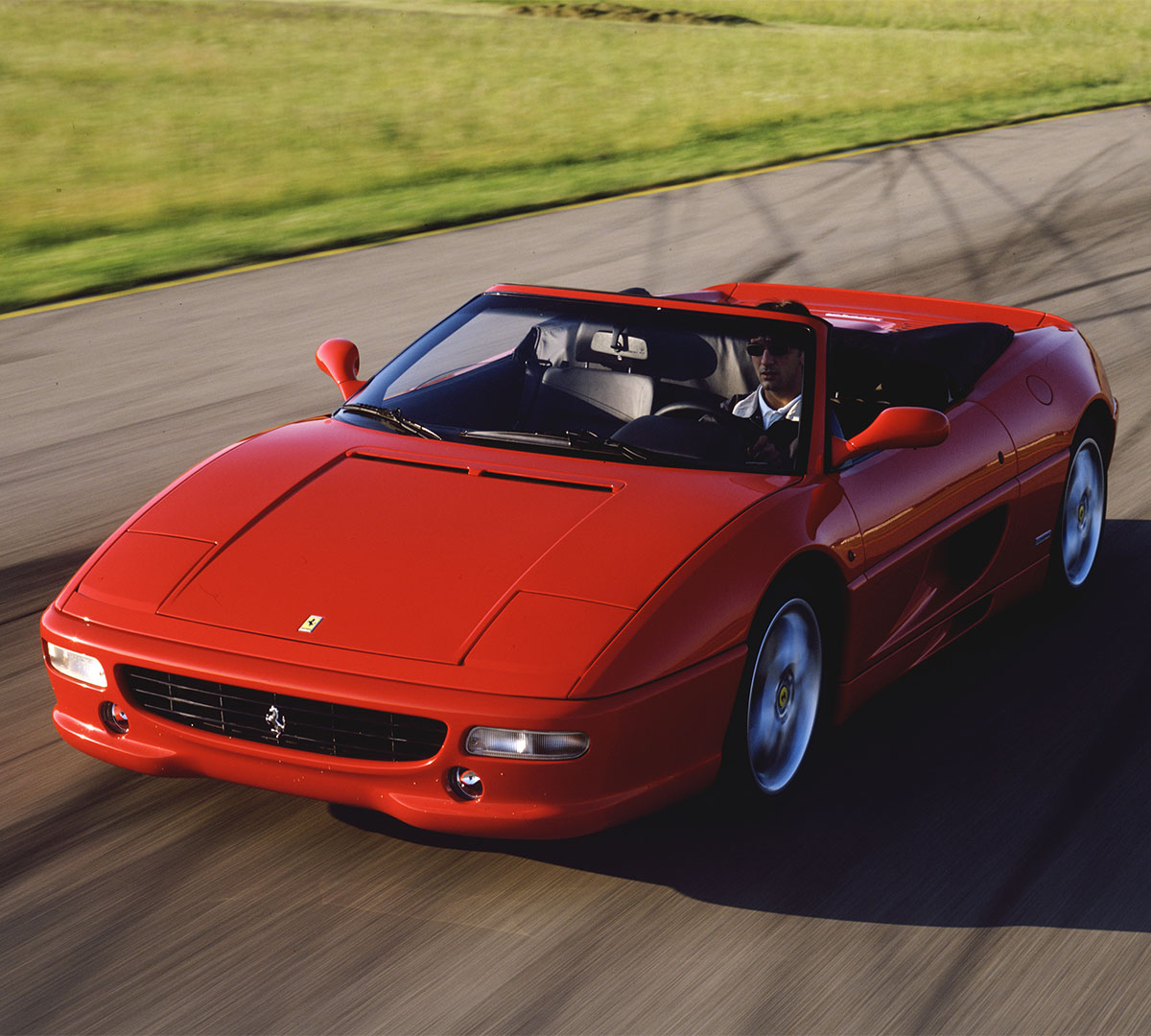?width=1920&height=1600)
Ferrari 355 F1 Spider
This was the first ever road car to be equipped with the innovative F1-style gearbox management system, available on all three versions: berlinetta, GTS and spider.

Electro-hydraulic system
Derived directly from Formula 1, where it made its debut in 1989 winning the Brazilian Grand Prix, the electro-hydraulic system was operated by paddles behind the steering wheel using the F355′s conventional 6-speed manual gearbox.
The new transmission guaranteed lightning-quick gear changes, with the additional advantage that both the driver’s hands could stay on the wheel at all times.

The first Ferrari ever built was an open-top. Spiders always held a very special and vital place in Enzo Ferraris’ heart and later in that of the company itself. The inspiration behind every Ferrari spider is a mix of a genuinely sporty engineering and the thrill of open-top driving.
The 355 F1 Spider brought this spirit to a whole new level by melding the berlinetta and the GTS’s acknowledged performance with a superbly efficient electronically-operated semi-automatic soft top.

The factors that made the F355 such a successful model made the transition unaltered to the Pininfarina-styled 355 F1 Spider: a very elastic 380 hp engine with five valves per cylinder, 109 hp/litre specific power output, 4.7-second 0 a 100 km/h sprinting and 37 Kgm of torque. With respect to the F355 Spider, the 355 F1 Spider had an F1-style gearbox management system.
Just like the one used for the single-seater, the electro-hydraulic system controlled the manual gearbox using sophisticated software. It was itself operated via two paddles, one on each side of the steering wheel, which meant that the driver did not have to take his hands off the steering wheel whilst changing gears either.

The two-seater 355 F1 Spider had an aluminium and steel body. Its styling was moulded around an aerodynamically severe design that included a full-body undertray designed to equalise downforce (Cl) between the two axles.
The cabin was designed with both safety and driving pleasure in mind. The seats and trim were Connolly leather. Composite racing seats were also available to order.
The chassis was a steel monocoque with a tubular steel rear sub-frame for the engine-suspension assembly. Both front and rear suspension used independent unequal-length wishbones and coil springs over gas-filled telescopic electronic dampers with two settings.
The car also has anti-roll bars.
The steering was rack and pinion with power-assist, and optional mechanical gear. The brakes had self-venting discs and excludable ABS ATE. The 18” wheel rims were magnesium.

The mid-rear 3496 cc 90° V8 was longitudinally mounted and punched out 380 hp, giving it a specific power output of 109 hp/l. Distribution was by means of twin overhead cams with five valves per cylinder. The con rods were titanium, while the control unit was the Bosch M5.2. Dry sump lubrication and a six-speed plus reverse mechanical gearbox completed the picture along with a dry single-plate clutch. It had an F1-style gearbox management system.

- V8ENGINE
- 3495.50 ccTOTAL DISPLACEMENT
- 279 kWMAXIMUM POWER @ 8250 rpm
- 295 km/hTOP SPEED
- Typerear, longitudinal 90° V8
- Bore/stroke85 x 77mm
- Unitary displacement436.94cc
- Total displacement3495.50cc
- Compression ratio11 : 1
- Maximum power279 kW (380 hp) at 8250 rpm
- Power per litre109hp/l
- Maximum torque363 Nm (37 kgm) at 6000 rpm
- Valve actuationtwin overhead camshafts per bank, five valves per cylinder
- Fuel feedBosch Motronic M5.2 electronic injection
- IgnitionBosch Motronic M5.2 static electronic, single spark plug per cylinder
- Lubricationdry sump
- Clutchsingle-plate
- Framesteel monocoque with tubular steel rear sub-frame
- Front suspensionindependent, unequal-length wishbones, coil springs over gas-filled telescopic shock absorbers, anti-roll bar
- Rear suspensionindependent, unequal-length wishbones, coil springs over gas-filled telescopic shock absorbers, anti-roll bar
- Brakesdiscs
- Transmissionelectro-hydraulic F1 6-speed + reverse
- Steeringrack-and-pinion
- Fuel tankcapacity 82litres
- Front tyres225/40 ZR 18
- Rear tyres265/40 ZR 18
- Typetwo-seater spider
- Length4250mm
- Width1900mm
- Height1170mm
- Wheelbase2450mm
- Front track1514mm
- Rear track1615mm
- Weight1350kg (dry)
- Top speed295km/h
- Acceleration 0-100 km/h4.7sec
- 0-400 m12.9sec
- 0-1000 m23.7sec
- history
- Technical Details
- media gallery